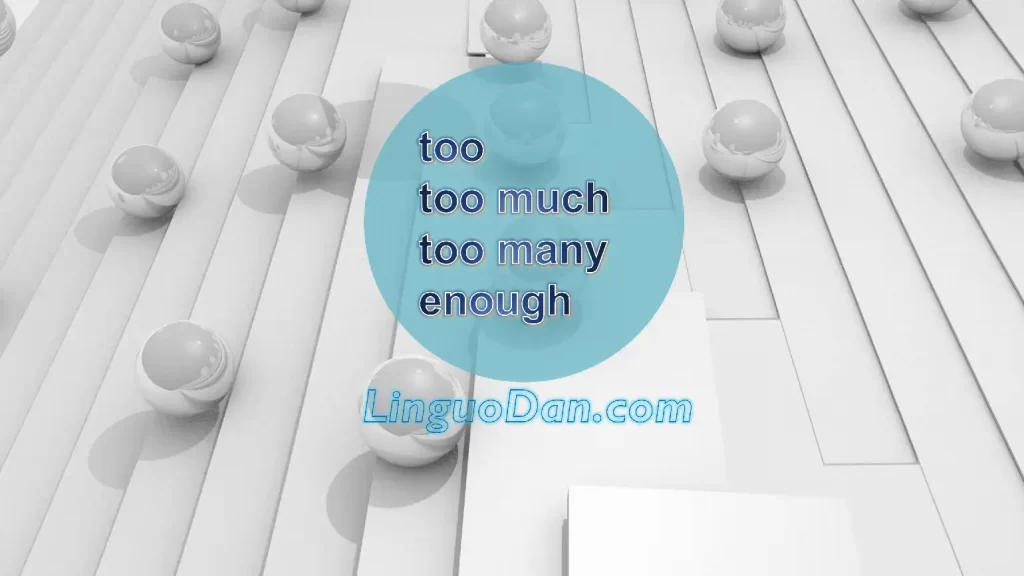Grammar of ‘Too,’ ‘Too Much,’ ‘Too Many,’ and ‘Enough’ in English

Usage rules: ‘Too,’ ‘Too Much,’ ‘Too Many,’ and ‘Enough’ in English grammar
Comprehending the subtleties of “too,” “too much,” “too many,” and “enough” in English involves not just understanding their usage but also grasping the underlying grammar. Let’s explore each concept with a focus on grammar, especially when these terms are combined with the infinitive form “to.”
In English, “too,” “too much,” “too many,” and “enough” are used to express quantity, measure, or degree of quality, indicating whether something is more, less, or as needed. Let’s look at the common uses of each:
- “Too”: Indicates that the amount, measure, or degree of something exceeds or falls short of an appropriate standard or need. It is usually used before adjectives, adverbs or infinitives.
- Example: The soup is too hot.
- “Too Much”: Used to describe an excessive number of indeclinable nouns.
- Example: I’ve had too much coffee today.
- “Too Many”: Indicates an excessive number of declinable nouns.
- Example: There are too many people in the room.
- “Enough”: Used to express that the amount, measure, or degree of something is sufficient or meets a particular need or standard.
- Example: Do you have enough time to finish the assignment?
Definition and Usage of “Too” in English
Definition: The word “too” is an adverb that is used to indicate an excess or an extreme degree of a quality or condition. It conveys the idea of more than what is necessary, suitable, or desirable.
Usage:
- Before an Adjective/Adverb:
- Example: She is too tired to continue working. (Excessive tiredness)
- Before an Uncountable Noun:
- Example: The coffee is too hot to drink. (Excessive temperature)
- Before a Countable Noun (with “many”):
- Example: There were too many people in the small room. (Excessive number)
- In Combination with “To” + Infinitive:
- Example: He is too busy to attend the meeting. (Excessive busyness preventing attendance)
- Expressing Agreement or Confirmation:
- Example: “I enjoyed the movie.” – “I did too!” (Expressing agreement or concurrence)
Note: The placement of “too” in a sentence is crucial for conveying the intended meaning. When used correctly, it adds precision to the expression of excess or extremity in various contexts.
1. “Too” + To + Infinitive: Expressing Impossibility or Excess
- Example: She is too young to enter this club.
- Grammar Explanation: “Too” acts as an adverb modifying the adjective “young,” indicating an excess that renders the person ineligible for club entry.
2. “Too Much” + To + Infinitive: Indicating Excessive Quantity in Uncountable Nouns
- Example: The doctor said that I drink too much coffee.
- Grammar Explanation: “Too much” serves as a quantifier modifying the uncountable noun “coffee,” signifying an excessive amount that the doctor advises against.
3. “Too Many” + To + Infinitive: Signifying an Undesirable Abundance in Plural Nouns
- Example: I didn’t enjoy the concert. There were too many people.
- Grammar Explanation: “Too many” acts as a quantifier modifying the plural noun “people,” indicating an undesirable abundance that affected the enjoyment of the concert.
4. “Enough” + To + Infinitive: Demonstrating Adequacy for a Specific Purpose
- Example: I have saved enough money to go to Rome on holiday.
- Grammar Explanation: “Enough” is used as a determiner modifying the noun “money,” indicating sufficiency for the specified purpose of funding a holiday.
5. “Enough” + To + Infinitive: Indicating Sufficient Adjective/Adverb for a Task
- Example: This bed is big enough for the four of us.
- Grammar Explanation: “Enough” functions as an adverb modifying the adjective “big,” indicating sufficiency for accommodating the specified number of people.
6. “Enough” + To + Infinitive: Representing Sufficient Verb for an Action
- Example: I didn’t study enough and I failed the exam.
- Grammar Explanation: “Enough” modifies the verb “study,” indicating the insufficient amount that led to exam failure.
7. “Not” + Enough + To + Infinitive: Expressing Insufficiency in Various Contexts
- Example: You aren’t old enough to enter this club.
- Grammar Explanation: The negation “not” is combined with “enough” to indicate insufficiency, specifically in age for club entry.
8. “Not” + Adjective/Adverb + Enough + To + Infinitive: Denoting Lack of Sufficiency
- Example: You aren’t going fast enough. We are going to be late.
- Grammar Explanation: The negation “not” is applied to the adjective “fast enough,” indicating the lack of sufficient speed and the potential consequence of being late.
Practice for consolidation – Too many-Too much-enough
Understanding these grammar nuances enhances your ability to use “too,” “too much,” “too many,” and “enough” effectively in various contexts. Practice incorporating these structures into your sentences to solidify your grasp of English grammar.